BUS3011: Cross-Cultural Analysis of Crockett & Jones' China Expansion
VerifiedAdded on 2023/01/03
|9
|3301
|97
Report
AI Summary
This report provides a detailed analysis of cross-cultural business strategies, specifically focusing on how companies like Crockett & Jones analyze cultural differences when expanding into new markets, such as China. The report emphasizes the importance of understanding cultural nuances and utilizing frameworks like Hofstede's cultural dimensions to navigate these differences effectively. It explores how factors such as power distance, individualism versus collectivism, uncertainty avoidance, masculinity versus femininity, and long-term versus short-term orientation influence business practices and consumer behavior. By examining these dimensions, the report highlights the challenges and opportunities that arise in international business and offers insights into adapting strategies to succeed in diverse cultural contexts. The document is contributed by a student and available on Desklib, a platform offering AI-based study tools.

BUS3011HR-
related issues
related issues
Paraphrase This Document
Need a fresh take? Get an instant paraphrase of this document with our AI Paraphraser
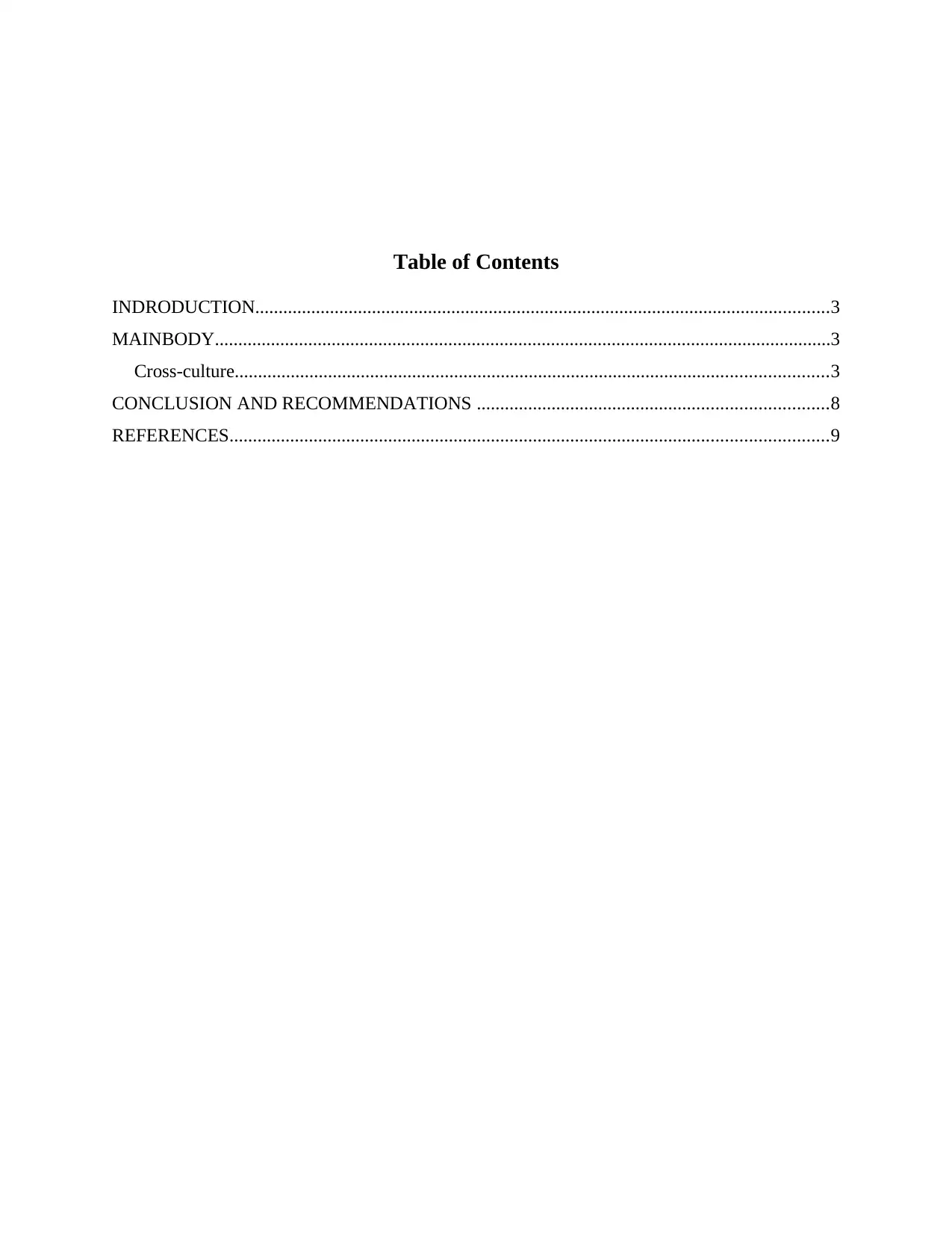
Table of Contents
INDRODUCTION...........................................................................................................................3
MAINBODY....................................................................................................................................3
Cross-culture...............................................................................................................................3
CONCLUSION AND RECOMMENDATIONS ...........................................................................8
REFERENCES................................................................................................................................9
INDRODUCTION...........................................................................................................................3
MAINBODY....................................................................................................................................3
Cross-culture...............................................................................................................................3
CONCLUSION AND RECOMMENDATIONS ...........................................................................8
REFERENCES................................................................................................................................9
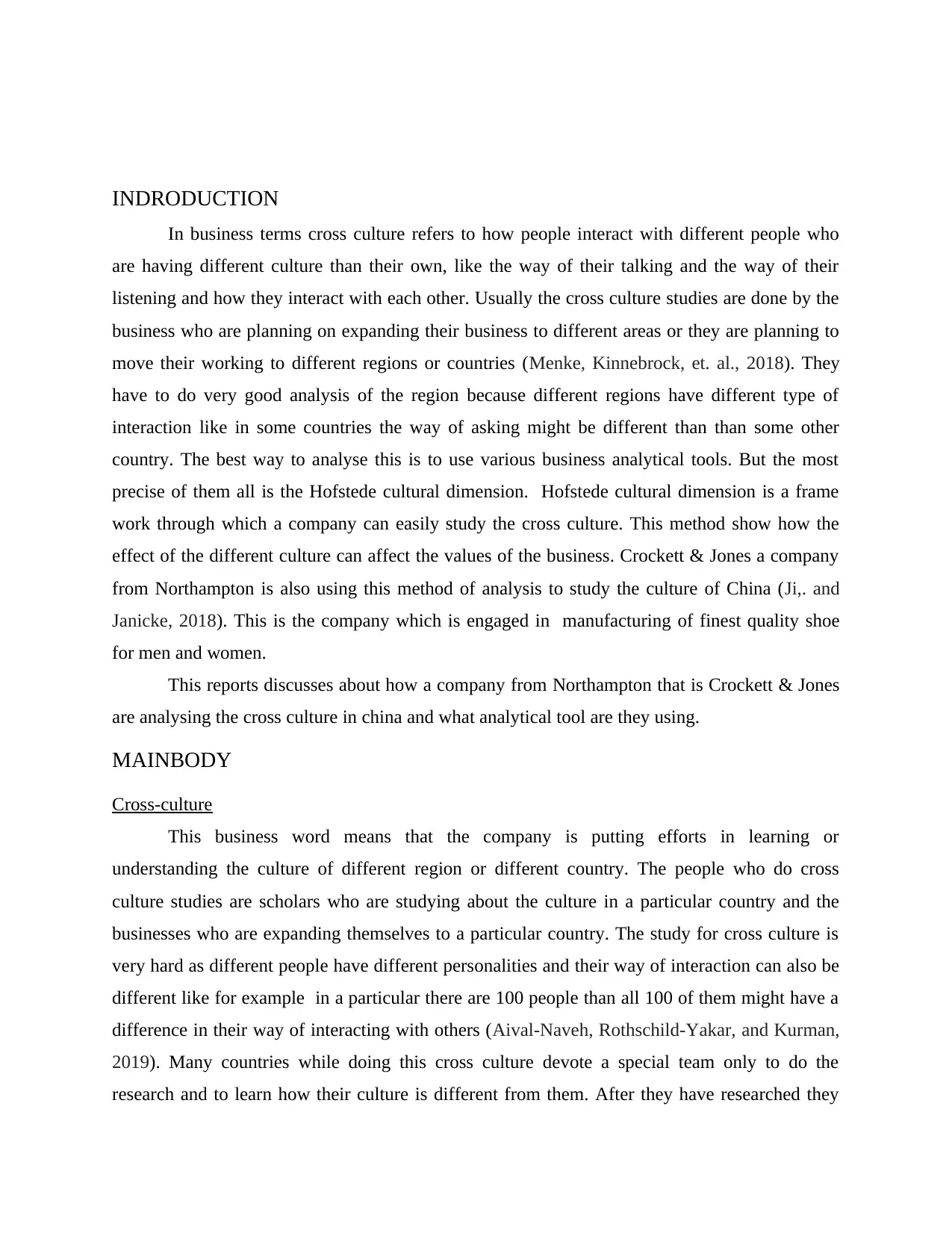
INDRODUCTION
In business terms cross culture refers to how people interact with different people who
are having different culture than their own, like the way of their talking and the way of their
listening and how they interact with each other. Usually the cross culture studies are done by the
business who are planning on expanding their business to different areas or they are planning to
move their working to different regions or countries (Menke, Kinnebrock, et. al., 2018). They
have to do very good analysis of the region because different regions have different type of
interaction like in some countries the way of asking might be different than than some other
country. The best way to analyse this is to use various business analytical tools. But the most
precise of them all is the Hofstede cultural dimension. Hofstede cultural dimension is a frame
work through which a company can easily study the cross culture. This method show how the
effect of the different culture can affect the values of the business. Crockett & Jones a company
from Northampton is also using this method of analysis to study the culture of China (Ji,. and
Janicke, 2018). This is the company which is engaged in manufacturing of finest quality shoe
for men and women.
This reports discusses about how a company from Northampton that is Crockett & Jones
are analysing the cross culture in china and what analytical tool are they using.
MAINBODY
Cross-culture
This business word means that the company is putting efforts in learning or
understanding the culture of different region or different country. The people who do cross
culture studies are scholars who are studying about the culture in a particular country and the
businesses who are expanding themselves to a particular country. The study for cross culture is
very hard as different people have different personalities and their way of interaction can also be
different like for example in a particular there are 100 people than all 100 of them might have a
difference in their way of interacting with others (Aival-Naveh, Rothschild‐Yakar, and Kurman,
2019). Many countries while doing this cross culture devote a special team only to do the
research and to learn how their culture is different from them. After they have researched they
In business terms cross culture refers to how people interact with different people who
are having different culture than their own, like the way of their talking and the way of their
listening and how they interact with each other. Usually the cross culture studies are done by the
business who are planning on expanding their business to different areas or they are planning to
move their working to different regions or countries (Menke, Kinnebrock, et. al., 2018). They
have to do very good analysis of the region because different regions have different type of
interaction like in some countries the way of asking might be different than than some other
country. The best way to analyse this is to use various business analytical tools. But the most
precise of them all is the Hofstede cultural dimension. Hofstede cultural dimension is a frame
work through which a company can easily study the cross culture. This method show how the
effect of the different culture can affect the values of the business. Crockett & Jones a company
from Northampton is also using this method of analysis to study the culture of China (Ji,. and
Janicke, 2018). This is the company which is engaged in manufacturing of finest quality shoe
for men and women.
This reports discusses about how a company from Northampton that is Crockett & Jones
are analysing the cross culture in china and what analytical tool are they using.
MAINBODY
Cross-culture
This business word means that the company is putting efforts in learning or
understanding the culture of different region or different country. The people who do cross
culture studies are scholars who are studying about the culture in a particular country and the
businesses who are expanding themselves to a particular country. The study for cross culture is
very hard as different people have different personalities and their way of interaction can also be
different like for example in a particular there are 100 people than all 100 of them might have a
difference in their way of interacting with others (Aival-Naveh, Rothschild‐Yakar, and Kurman,
2019). Many countries while doing this cross culture devote a special team only to do the
research and to learn how their culture is different from them. After they have researched they
⊘ This is a preview!⊘
Do you want full access?
Subscribe today to unlock all pages.

Trusted by 1+ million students worldwide
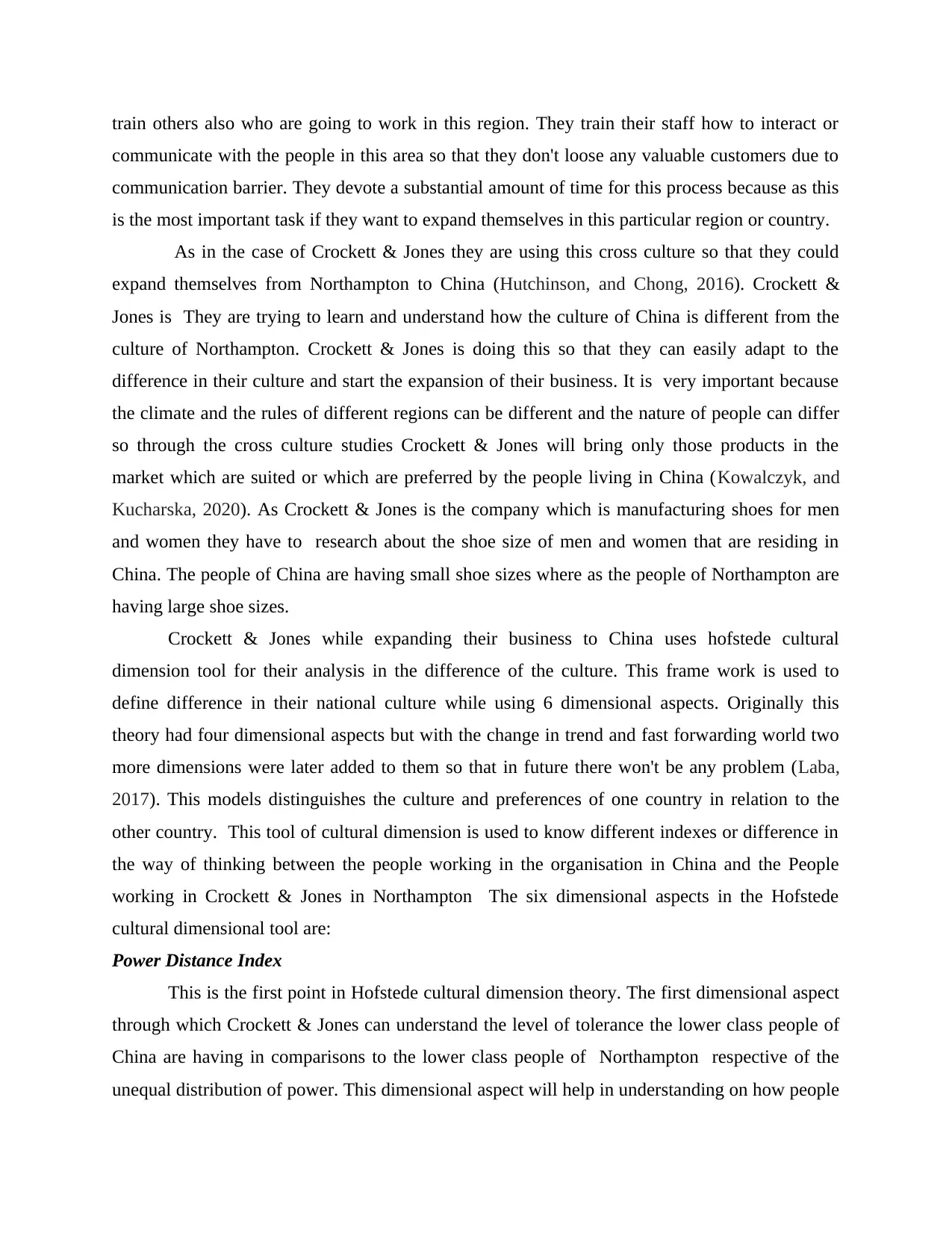
train others also who are going to work in this region. They train their staff how to interact or
communicate with the people in this area so that they don't loose any valuable customers due to
communication barrier. They devote a substantial amount of time for this process because as this
is the most important task if they want to expand themselves in this particular region or country.
As in the case of Crockett & Jones they are using this cross culture so that they could
expand themselves from Northampton to China (Hutchinson, and Chong, 2016). Crockett &
Jones is They are trying to learn and understand how the culture of China is different from the
culture of Northampton. Crockett & Jones is doing this so that they can easily adapt to the
difference in their culture and start the expansion of their business. It is very important because
the climate and the rules of different regions can be different and the nature of people can differ
so through the cross culture studies Crockett & Jones will bring only those products in the
market which are suited or which are preferred by the people living in China (Kowalczyk, and
Kucharska, 2020). As Crockett & Jones is the company which is manufacturing shoes for men
and women they have to research about the shoe size of men and women that are residing in
China. The people of China are having small shoe sizes where as the people of Northampton are
having large shoe sizes.
Crockett & Jones while expanding their business to China uses hofstede cultural
dimension tool for their analysis in the difference of the culture. This frame work is used to
define difference in their national culture while using 6 dimensional aspects. Originally this
theory had four dimensional aspects but with the change in trend and fast forwarding world two
more dimensions were later added to them so that in future there won't be any problem (Laba,
2017). This models distinguishes the culture and preferences of one country in relation to the
other country. This tool of cultural dimension is used to know different indexes or difference in
the way of thinking between the people working in the organisation in China and the People
working in Crockett & Jones in Northampton The six dimensional aspects in the Hofstede
cultural dimensional tool are:
Power Distance Index
This is the first point in Hofstede cultural dimension theory. The first dimensional aspect
through which Crockett & Jones can understand the level of tolerance the lower class people of
China are having in comparisons to the lower class people of Northampton respective of the
unequal distribution of power. This dimensional aspect will help in understanding on how people
communicate with the people in this area so that they don't loose any valuable customers due to
communication barrier. They devote a substantial amount of time for this process because as this
is the most important task if they want to expand themselves in this particular region or country.
As in the case of Crockett & Jones they are using this cross culture so that they could
expand themselves from Northampton to China (Hutchinson, and Chong, 2016). Crockett &
Jones is They are trying to learn and understand how the culture of China is different from the
culture of Northampton. Crockett & Jones is doing this so that they can easily adapt to the
difference in their culture and start the expansion of their business. It is very important because
the climate and the rules of different regions can be different and the nature of people can differ
so through the cross culture studies Crockett & Jones will bring only those products in the
market which are suited or which are preferred by the people living in China (Kowalczyk, and
Kucharska, 2020). As Crockett & Jones is the company which is manufacturing shoes for men
and women they have to research about the shoe size of men and women that are residing in
China. The people of China are having small shoe sizes where as the people of Northampton are
having large shoe sizes.
Crockett & Jones while expanding their business to China uses hofstede cultural
dimension tool for their analysis in the difference of the culture. This frame work is used to
define difference in their national culture while using 6 dimensional aspects. Originally this
theory had four dimensional aspects but with the change in trend and fast forwarding world two
more dimensions were later added to them so that in future there won't be any problem (Laba,
2017). This models distinguishes the culture and preferences of one country in relation to the
other country. This tool of cultural dimension is used to know different indexes or difference in
the way of thinking between the people working in the organisation in China and the People
working in Crockett & Jones in Northampton The six dimensional aspects in the Hofstede
cultural dimensional tool are:
Power Distance Index
This is the first point in Hofstede cultural dimension theory. The first dimensional aspect
through which Crockett & Jones can understand the level of tolerance the lower class people of
China are having in comparisons to the lower class people of Northampton respective of the
unequal distribution of power. This dimensional aspect will help in understanding on how people
Paraphrase This Document
Need a fresh take? Get an instant paraphrase of this document with our AI Paraphraser
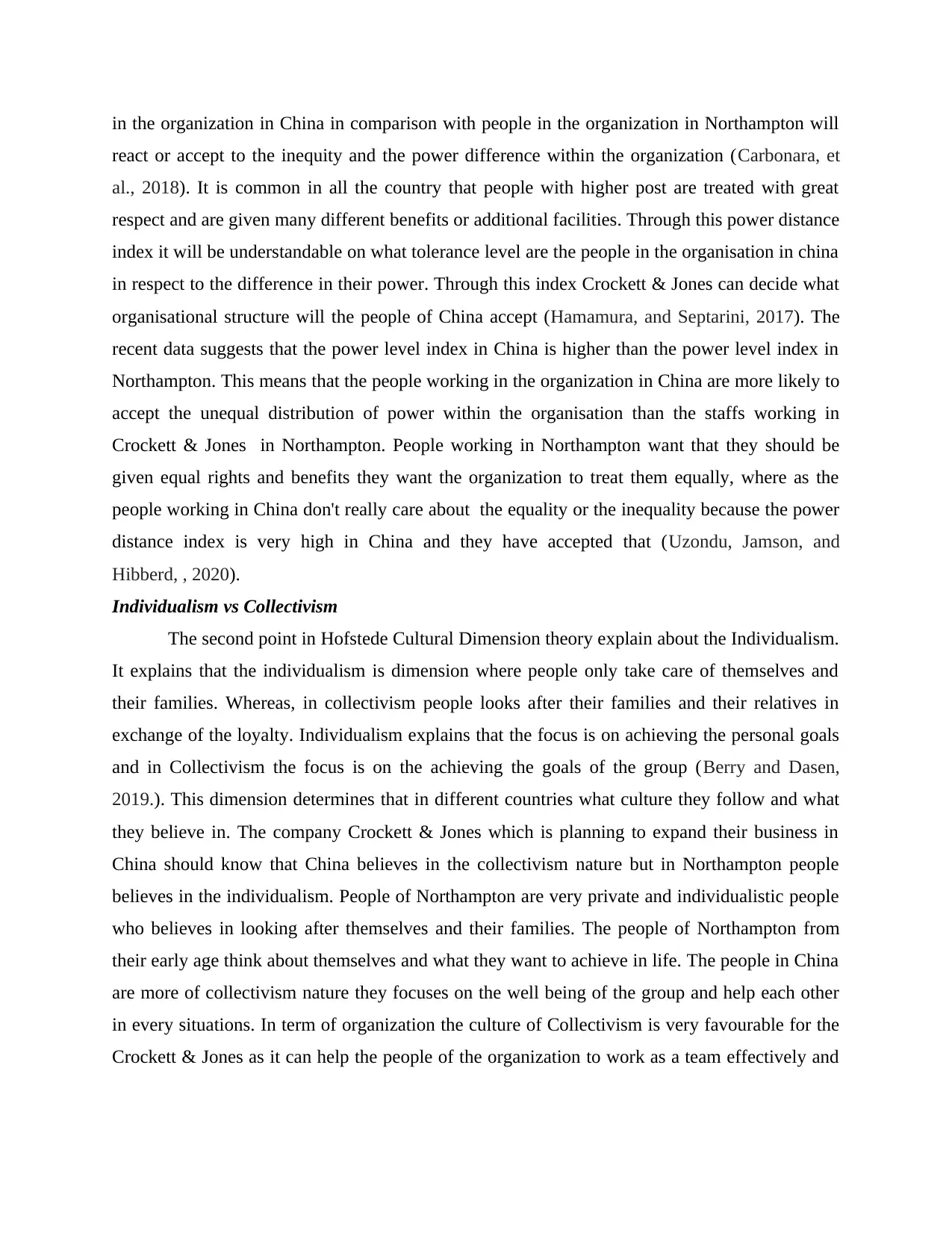
in the organization in China in comparison with people in the organization in Northampton will
react or accept to the inequity and the power difference within the organization (Carbonara, et
al., 2018). It is common in all the country that people with higher post are treated with great
respect and are given many different benefits or additional facilities. Through this power distance
index it will be understandable on what tolerance level are the people in the organisation in china
in respect to the difference in their power. Through this index Crockett & Jones can decide what
organisational structure will the people of China accept (Hamamura, and Septarini, 2017). The
recent data suggests that the power level index in China is higher than the power level index in
Northampton. This means that the people working in the organization in China are more likely to
accept the unequal distribution of power within the organisation than the staffs working in
Crockett & Jones in Northampton. People working in Northampton want that they should be
given equal rights and benefits they want the organization to treat them equally, where as the
people working in China don't really care about the equality or the inequality because the power
distance index is very high in China and they have accepted that (Uzondu, Jamson, and
Hibberd, , 2020).
Individualism vs Collectivism
The second point in Hofstede Cultural Dimension theory explain about the Individualism.
It explains that the individualism is dimension where people only take care of themselves and
their families. Whereas, in collectivism people looks after their families and their relatives in
exchange of the loyalty. Individualism explains that the focus is on achieving the personal goals
and in Collectivism the focus is on the achieving the goals of the group (Berry and Dasen,
2019.). This dimension determines that in different countries what culture they follow and what
they believe in. The company Crockett & Jones which is planning to expand their business in
China should know that China believes in the collectivism nature but in Northampton people
believes in the individualism. People of Northampton are very private and individualistic people
who believes in looking after themselves and their families. The people of Northampton from
their early age think about themselves and what they want to achieve in life. The people in China
are more of collectivism nature they focuses on the well being of the group and help each other
in every situations. In term of organization the culture of Collectivism is very favourable for the
Crockett & Jones as it can help the people of the organization to work as a team effectively and
react or accept to the inequity and the power difference within the organization (Carbonara, et
al., 2018). It is common in all the country that people with higher post are treated with great
respect and are given many different benefits or additional facilities. Through this power distance
index it will be understandable on what tolerance level are the people in the organisation in china
in respect to the difference in their power. Through this index Crockett & Jones can decide what
organisational structure will the people of China accept (Hamamura, and Septarini, 2017). The
recent data suggests that the power level index in China is higher than the power level index in
Northampton. This means that the people working in the organization in China are more likely to
accept the unequal distribution of power within the organisation than the staffs working in
Crockett & Jones in Northampton. People working in Northampton want that they should be
given equal rights and benefits they want the organization to treat them equally, where as the
people working in China don't really care about the equality or the inequality because the power
distance index is very high in China and they have accepted that (Uzondu, Jamson, and
Hibberd, , 2020).
Individualism vs Collectivism
The second point in Hofstede Cultural Dimension theory explain about the Individualism.
It explains that the individualism is dimension where people only take care of themselves and
their families. Whereas, in collectivism people looks after their families and their relatives in
exchange of the loyalty. Individualism explains that the focus is on achieving the personal goals
and in Collectivism the focus is on the achieving the goals of the group (Berry and Dasen,
2019.). This dimension determines that in different countries what culture they follow and what
they believe in. The company Crockett & Jones which is planning to expand their business in
China should know that China believes in the collectivism nature but in Northampton people
believes in the individualism. People of Northampton are very private and individualistic people
who believes in looking after themselves and their families. The people of Northampton from
their early age think about themselves and what they want to achieve in life. The people in China
are more of collectivism nature they focuses on the well being of the group and help each other
in every situations. In term of organization the culture of Collectivism is very favourable for the
Crockett & Jones as it can help the people of the organization to work as a team effectively and
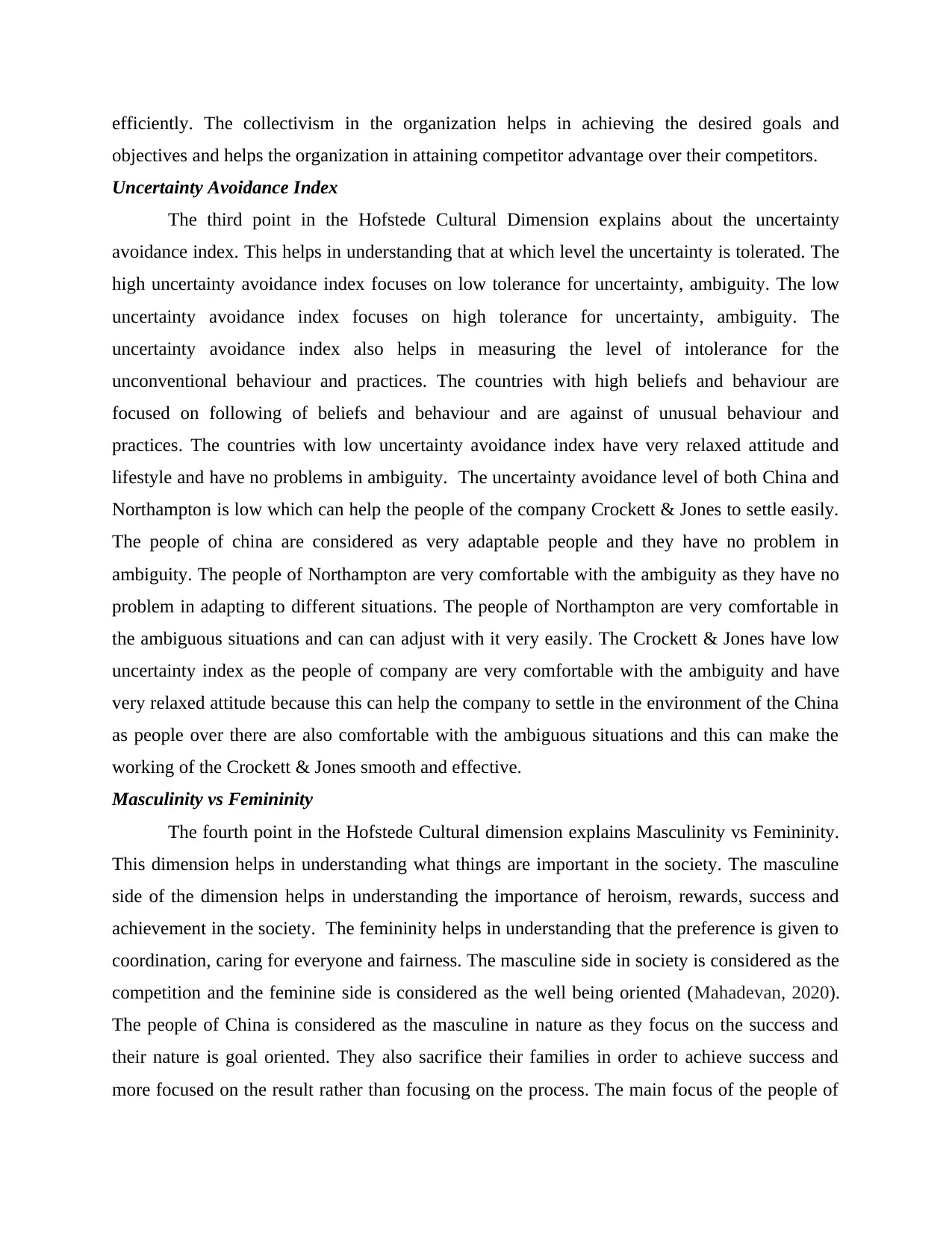
efficiently. The collectivism in the organization helps in achieving the desired goals and
objectives and helps the organization in attaining competitor advantage over their competitors.
Uncertainty Avoidance Index
The third point in the Hofstede Cultural Dimension explains about the uncertainty
avoidance index. This helps in understanding that at which level the uncertainty is tolerated. The
high uncertainty avoidance index focuses on low tolerance for uncertainty, ambiguity. The low
uncertainty avoidance index focuses on high tolerance for uncertainty, ambiguity. The
uncertainty avoidance index also helps in measuring the level of intolerance for the
unconventional behaviour and practices. The countries with high beliefs and behaviour are
focused on following of beliefs and behaviour and are against of unusual behaviour and
practices. The countries with low uncertainty avoidance index have very relaxed attitude and
lifestyle and have no problems in ambiguity. The uncertainty avoidance level of both China and
Northampton is low which can help the people of the company Crockett & Jones to settle easily.
The people of china are considered as very adaptable people and they have no problem in
ambiguity. The people of Northampton are very comfortable with the ambiguity as they have no
problem in adapting to different situations. The people of Northampton are very comfortable in
the ambiguous situations and can can adjust with it very easily. The Crockett & Jones have low
uncertainty index as the people of company are very comfortable with the ambiguity and have
very relaxed attitude because this can help the company to settle in the environment of the China
as people over there are also comfortable with the ambiguous situations and this can make the
working of the Crockett & Jones smooth and effective.
Masculinity vs Femininity
The fourth point in the Hofstede Cultural dimension explains Masculinity vs Femininity.
This dimension helps in understanding what things are important in the society. The masculine
side of the dimension helps in understanding the importance of heroism, rewards, success and
achievement in the society. The femininity helps in understanding that the preference is given to
coordination, caring for everyone and fairness. The masculine side in society is considered as the
competition and the feminine side is considered as the well being oriented (Mahadevan, 2020).
The people of China is considered as the masculine in nature as they focus on the success and
their nature is goal oriented. They also sacrifice their families in order to achieve success and
more focused on the result rather than focusing on the process. The main focus of the people of
objectives and helps the organization in attaining competitor advantage over their competitors.
Uncertainty Avoidance Index
The third point in the Hofstede Cultural Dimension explains about the uncertainty
avoidance index. This helps in understanding that at which level the uncertainty is tolerated. The
high uncertainty avoidance index focuses on low tolerance for uncertainty, ambiguity. The low
uncertainty avoidance index focuses on high tolerance for uncertainty, ambiguity. The
uncertainty avoidance index also helps in measuring the level of intolerance for the
unconventional behaviour and practices. The countries with high beliefs and behaviour are
focused on following of beliefs and behaviour and are against of unusual behaviour and
practices. The countries with low uncertainty avoidance index have very relaxed attitude and
lifestyle and have no problems in ambiguity. The uncertainty avoidance level of both China and
Northampton is low which can help the people of the company Crockett & Jones to settle easily.
The people of china are considered as very adaptable people and they have no problem in
ambiguity. The people of Northampton are very comfortable with the ambiguity as they have no
problem in adapting to different situations. The people of Northampton are very comfortable in
the ambiguous situations and can can adjust with it very easily. The Crockett & Jones have low
uncertainty index as the people of company are very comfortable with the ambiguity and have
very relaxed attitude because this can help the company to settle in the environment of the China
as people over there are also comfortable with the ambiguous situations and this can make the
working of the Crockett & Jones smooth and effective.
Masculinity vs Femininity
The fourth point in the Hofstede Cultural dimension explains Masculinity vs Femininity.
This dimension helps in understanding what things are important in the society. The masculine
side of the dimension helps in understanding the importance of heroism, rewards, success and
achievement in the society. The femininity helps in understanding that the preference is given to
coordination, caring for everyone and fairness. The masculine side in society is considered as the
competition and the feminine side is considered as the well being oriented (Mahadevan, 2020).
The people of China is considered as the masculine in nature as they focus on the success and
their nature is goal oriented. They also sacrifice their families in order to achieve success and
more focused on the result rather than focusing on the process. The main focus of the people of
⊘ This is a preview!⊘
Do you want full access?
Subscribe today to unlock all pages.

Trusted by 1+ million students worldwide
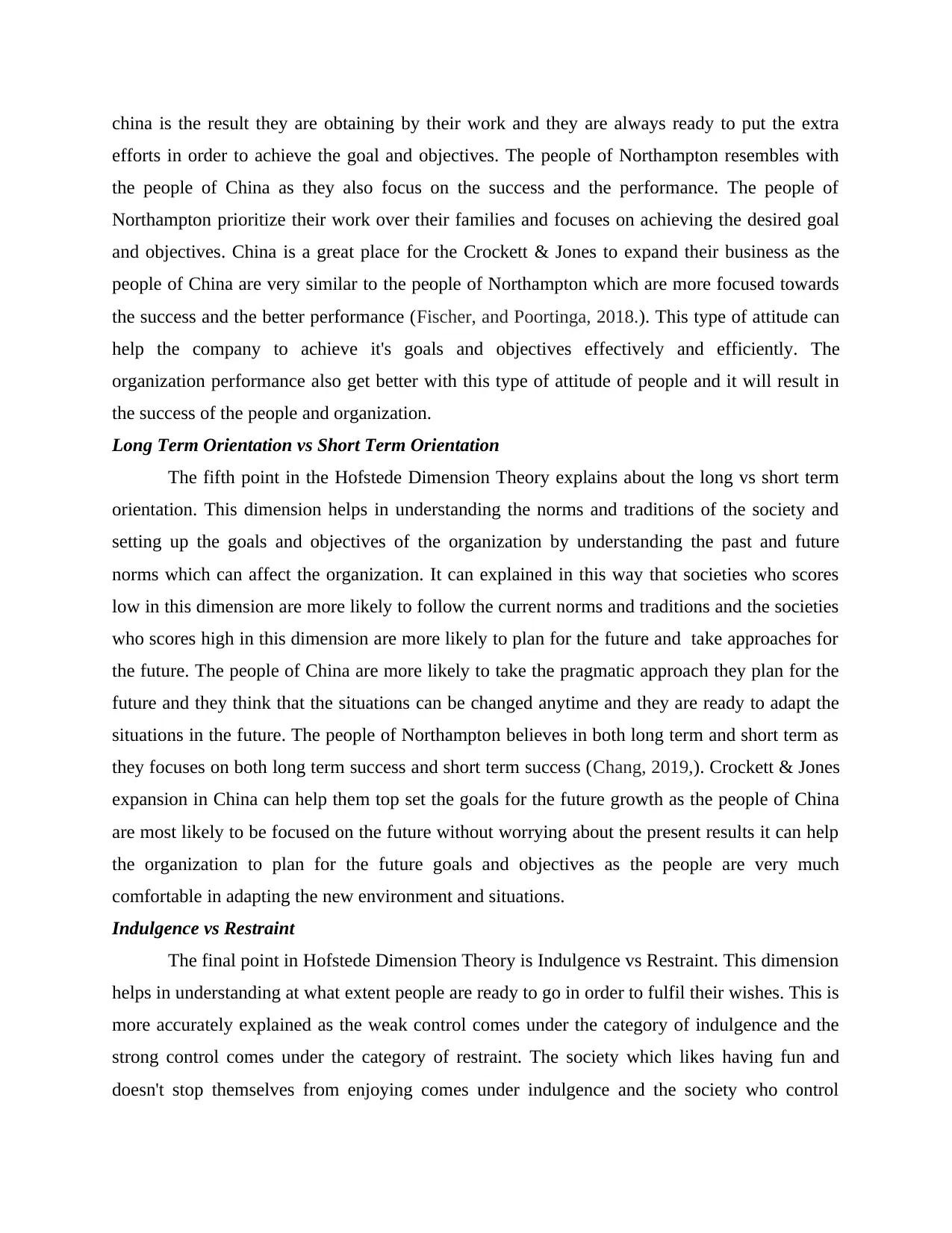
china is the result they are obtaining by their work and they are always ready to put the extra
efforts in order to achieve the goal and objectives. The people of Northampton resembles with
the people of China as they also focus on the success and the performance. The people of
Northampton prioritize their work over their families and focuses on achieving the desired goal
and objectives. China is a great place for the Crockett & Jones to expand their business as the
people of China are very similar to the people of Northampton which are more focused towards
the success and the better performance (Fischer, and Poortinga, 2018.). This type of attitude can
help the company to achieve it's goals and objectives effectively and efficiently. The
organization performance also get better with this type of attitude of people and it will result in
the success of the people and organization.
Long Term Orientation vs Short Term Orientation
The fifth point in the Hofstede Dimension Theory explains about the long vs short term
orientation. This dimension helps in understanding the norms and traditions of the society and
setting up the goals and objectives of the organization by understanding the past and future
norms which can affect the organization. It can explained in this way that societies who scores
low in this dimension are more likely to follow the current norms and traditions and the societies
who scores high in this dimension are more likely to plan for the future and take approaches for
the future. The people of China are more likely to take the pragmatic approach they plan for the
future and they think that the situations can be changed anytime and they are ready to adapt the
situations in the future. The people of Northampton believes in both long term and short term as
they focuses on both long term success and short term success (Chang, 2019,). Crockett & Jones
expansion in China can help them top set the goals for the future growth as the people of China
are most likely to be focused on the future without worrying about the present results it can help
the organization to plan for the future goals and objectives as the people are very much
comfortable in adapting the new environment and situations.
Indulgence vs Restraint
The final point in Hofstede Dimension Theory is Indulgence vs Restraint. This dimension
helps in understanding at what extent people are ready to go in order to fulfil their wishes. This is
more accurately explained as the weak control comes under the category of indulgence and the
strong control comes under the category of restraint. The society which likes having fun and
doesn't stop themselves from enjoying comes under indulgence and the society who control
efforts in order to achieve the goal and objectives. The people of Northampton resembles with
the people of China as they also focus on the success and the performance. The people of
Northampton prioritize their work over their families and focuses on achieving the desired goal
and objectives. China is a great place for the Crockett & Jones to expand their business as the
people of China are very similar to the people of Northampton which are more focused towards
the success and the better performance (Fischer, and Poortinga, 2018.). This type of attitude can
help the company to achieve it's goals and objectives effectively and efficiently. The
organization performance also get better with this type of attitude of people and it will result in
the success of the people and organization.
Long Term Orientation vs Short Term Orientation
The fifth point in the Hofstede Dimension Theory explains about the long vs short term
orientation. This dimension helps in understanding the norms and traditions of the society and
setting up the goals and objectives of the organization by understanding the past and future
norms which can affect the organization. It can explained in this way that societies who scores
low in this dimension are more likely to follow the current norms and traditions and the societies
who scores high in this dimension are more likely to plan for the future and take approaches for
the future. The people of China are more likely to take the pragmatic approach they plan for the
future and they think that the situations can be changed anytime and they are ready to adapt the
situations in the future. The people of Northampton believes in both long term and short term as
they focuses on both long term success and short term success (Chang, 2019,). Crockett & Jones
expansion in China can help them top set the goals for the future growth as the people of China
are most likely to be focused on the future without worrying about the present results it can help
the organization to plan for the future goals and objectives as the people are very much
comfortable in adapting the new environment and situations.
Indulgence vs Restraint
The final point in Hofstede Dimension Theory is Indulgence vs Restraint. This dimension
helps in understanding at what extent people are ready to go in order to fulfil their wishes. This is
more accurately explained as the weak control comes under the category of indulgence and the
strong control comes under the category of restraint. The society which likes having fun and
doesn't stop themselves from enjoying comes under indulgence and the society who control
Paraphrase This Document
Need a fresh take? Get an instant paraphrase of this document with our AI Paraphraser
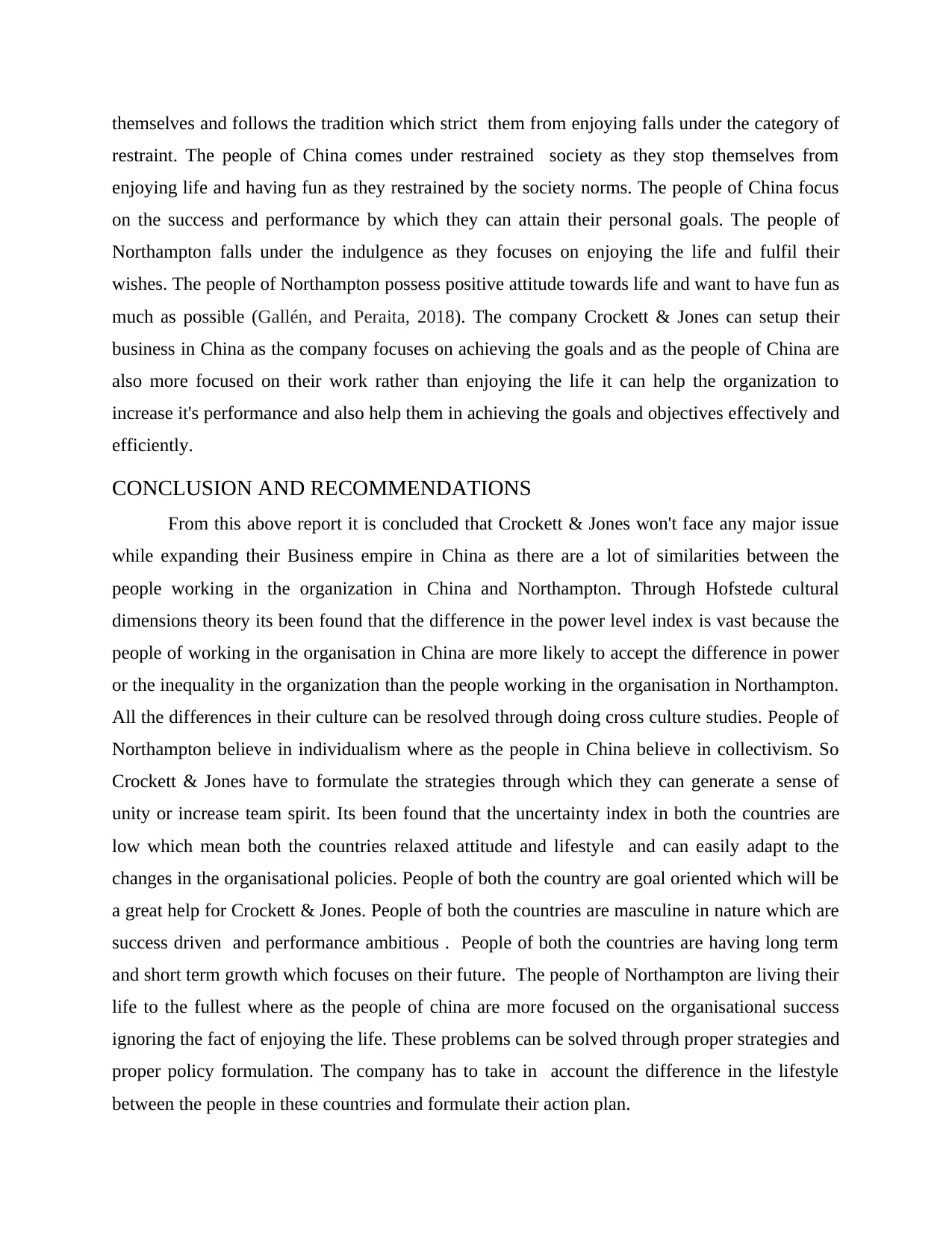
themselves and follows the tradition which strict them from enjoying falls under the category of
restraint. The people of China comes under restrained society as they stop themselves from
enjoying life and having fun as they restrained by the society norms. The people of China focus
on the success and performance by which they can attain their personal goals. The people of
Northampton falls under the indulgence as they focuses on enjoying the life and fulfil their
wishes. The people of Northampton possess positive attitude towards life and want to have fun as
much as possible (Gallén, and Peraita, 2018). The company Crockett & Jones can setup their
business in China as the company focuses on achieving the goals and as the people of China are
also more focused on their work rather than enjoying the life it can help the organization to
increase it's performance and also help them in achieving the goals and objectives effectively and
efficiently.
CONCLUSION AND RECOMMENDATIONS
From this above report it is concluded that Crockett & Jones won't face any major issue
while expanding their Business empire in China as there are a lot of similarities between the
people working in the organization in China and Northampton. Through Hofstede cultural
dimensions theory its been found that the difference in the power level index is vast because the
people of working in the organisation in China are more likely to accept the difference in power
or the inequality in the organization than the people working in the organisation in Northampton.
All the differences in their culture can be resolved through doing cross culture studies. People of
Northampton believe in individualism where as the people in China believe in collectivism. So
Crockett & Jones have to formulate the strategies through which they can generate a sense of
unity or increase team spirit. Its been found that the uncertainty index in both the countries are
low which mean both the countries relaxed attitude and lifestyle and can easily adapt to the
changes in the organisational policies. People of both the country are goal oriented which will be
a great help for Crockett & Jones. People of both the countries are masculine in nature which are
success driven and performance ambitious . People of both the countries are having long term
and short term growth which focuses on their future. The people of Northampton are living their
life to the fullest where as the people of china are more focused on the organisational success
ignoring the fact of enjoying the life. These problems can be solved through proper strategies and
proper policy formulation. The company has to take in account the difference in the lifestyle
between the people in these countries and formulate their action plan.
restraint. The people of China comes under restrained society as they stop themselves from
enjoying life and having fun as they restrained by the society norms. The people of China focus
on the success and performance by which they can attain their personal goals. The people of
Northampton falls under the indulgence as they focuses on enjoying the life and fulfil their
wishes. The people of Northampton possess positive attitude towards life and want to have fun as
much as possible (Gallén, and Peraita, 2018). The company Crockett & Jones can setup their
business in China as the company focuses on achieving the goals and as the people of China are
also more focused on their work rather than enjoying the life it can help the organization to
increase it's performance and also help them in achieving the goals and objectives effectively and
efficiently.
CONCLUSION AND RECOMMENDATIONS
From this above report it is concluded that Crockett & Jones won't face any major issue
while expanding their Business empire in China as there are a lot of similarities between the
people working in the organization in China and Northampton. Through Hofstede cultural
dimensions theory its been found that the difference in the power level index is vast because the
people of working in the organisation in China are more likely to accept the difference in power
or the inequality in the organization than the people working in the organisation in Northampton.
All the differences in their culture can be resolved through doing cross culture studies. People of
Northampton believe in individualism where as the people in China believe in collectivism. So
Crockett & Jones have to formulate the strategies through which they can generate a sense of
unity or increase team spirit. Its been found that the uncertainty index in both the countries are
low which mean both the countries relaxed attitude and lifestyle and can easily adapt to the
changes in the organisational policies. People of both the country are goal oriented which will be
a great help for Crockett & Jones. People of both the countries are masculine in nature which are
success driven and performance ambitious . People of both the countries are having long term
and short term growth which focuses on their future. The people of Northampton are living their
life to the fullest where as the people of china are more focused on the organisational success
ignoring the fact of enjoying the life. These problems can be solved through proper strategies and
proper policy formulation. The company has to take in account the difference in the lifestyle
between the people in these countries and formulate their action plan.
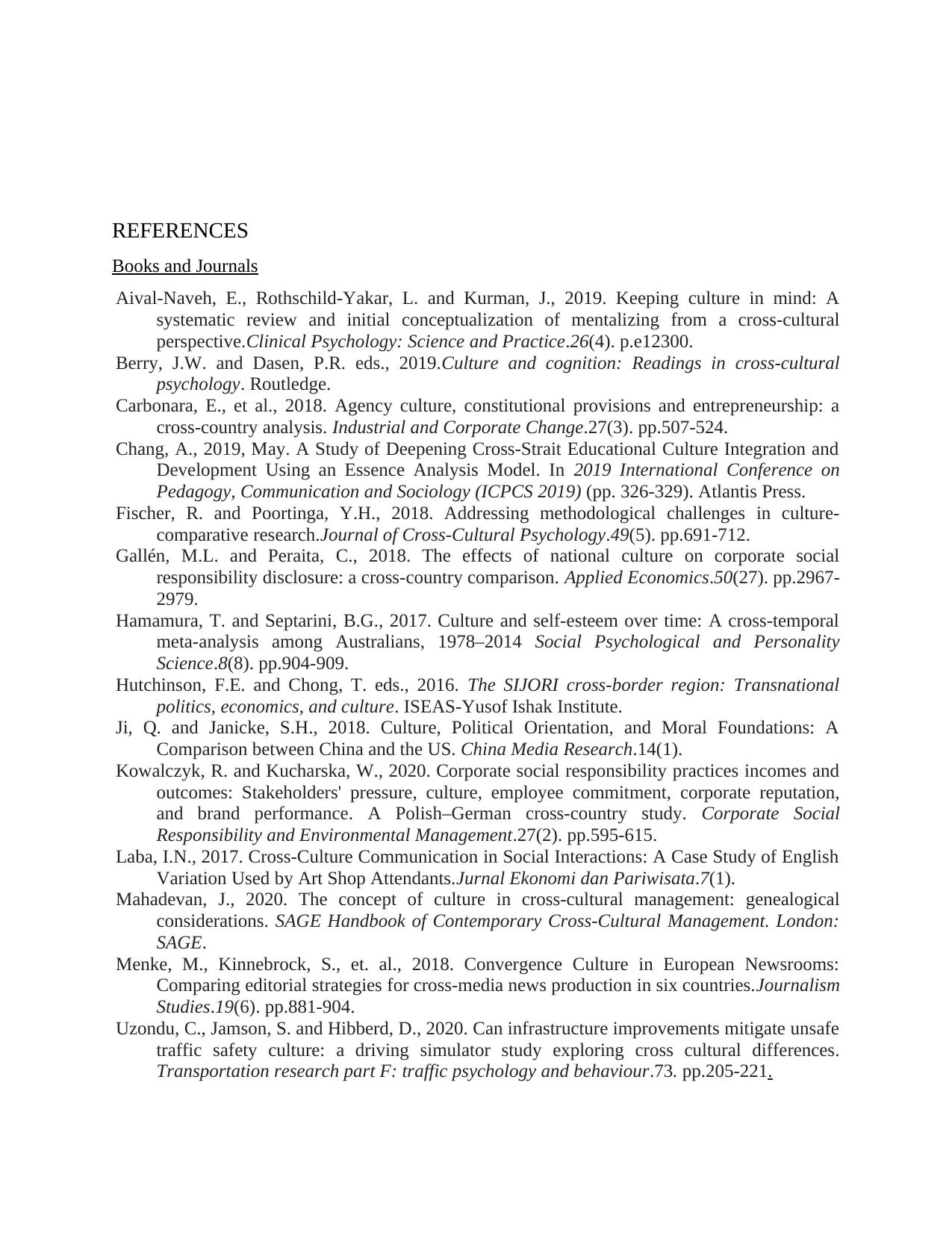
REFERENCES
Books and Journals
Aival-Naveh, E., Rothschild‐Yakar, L. and Kurman, J., 2019. Keeping culture in mind: A
systematic review and initial conceptualization of mentalizing from a cross‐cultural
perspective.Clinical Psychology: Science and Practice.26(4). p.e12300.
Berry, J.W. and Dasen, P.R. eds., 2019.Culture and cognition: Readings in cross-cultural
psychology. Routledge.
Carbonara, E., et al., 2018. Agency culture, constitutional provisions and entrepreneurship: a
cross-country analysis. Industrial and Corporate Change.27(3). pp.507-524.
Chang, A., 2019, May. A Study of Deepening Cross-Strait Educational Culture Integration and
Development Using an Essence Analysis Model. In 2019 International Conference on
Pedagogy, Communication and Sociology (ICPCS 2019) (pp. 326-329). Atlantis Press.
Fischer, R. and Poortinga, Y.H., 2018. Addressing methodological challenges in culture-
comparative research.Journal of Cross-Cultural Psychology.49(5). pp.691-712.
Gallén, M.L. and Peraita, C., 2018. The effects of national culture on corporate social
responsibility disclosure: a cross-country comparison. Applied Economics.50(27). pp.2967-
2979.
Hamamura, T. and Septarini, B.G., 2017. Culture and self-esteem over time: A cross-temporal
meta-analysis among Australians, 1978–2014 Social Psychological and Personality
Science.8(8). pp.904-909.
Hutchinson, F.E. and Chong, T. eds., 2016. The SIJORI cross-border region: Transnational
politics, economics, and culture. ISEAS-Yusof Ishak Institute.
Ji, Q. and Janicke, S.H., 2018. Culture, Political Orientation, and Moral Foundations: A
Comparison between China and the US. China Media Research.14(1).
Kowalczyk, R. and Kucharska, W., 2020. Corporate social responsibility practices incomes and
outcomes: Stakeholders' pressure, culture, employee commitment, corporate reputation,
and brand performance. A Polish–German cross‐country study. Corporate Social
Responsibility and Environmental Management.27(2). pp.595-615.
Laba, I.N., 2017. Cross-Culture Communication in Social Interactions: A Case Study of English
Variation Used by Art Shop Attendants.Jurnal Ekonomi dan Pariwisata.7(1).
Mahadevan, J., 2020. The concept of culture in cross-cultural management: genealogical
considerations. SAGE Handbook of Contemporary Cross-Cultural Management. London:
SAGE.
Menke, M., Kinnebrock, S., et. al., 2018. Convergence Culture in European Newsrooms:
Comparing editorial strategies for cross-media news production in six countries.Journalism
Studies.19(6). pp.881-904.
Uzondu, C., Jamson, S. and Hibberd, D., 2020. Can infrastructure improvements mitigate unsafe
traffic safety culture: a driving simulator study exploring cross cultural differences.
Transportation research part F: traffic psychology and behaviour.73. pp.205-221.
Books and Journals
Aival-Naveh, E., Rothschild‐Yakar, L. and Kurman, J., 2019. Keeping culture in mind: A
systematic review and initial conceptualization of mentalizing from a cross‐cultural
perspective.Clinical Psychology: Science and Practice.26(4). p.e12300.
Berry, J.W. and Dasen, P.R. eds., 2019.Culture and cognition: Readings in cross-cultural
psychology. Routledge.
Carbonara, E., et al., 2018. Agency culture, constitutional provisions and entrepreneurship: a
cross-country analysis. Industrial and Corporate Change.27(3). pp.507-524.
Chang, A., 2019, May. A Study of Deepening Cross-Strait Educational Culture Integration and
Development Using an Essence Analysis Model. In 2019 International Conference on
Pedagogy, Communication and Sociology (ICPCS 2019) (pp. 326-329). Atlantis Press.
Fischer, R. and Poortinga, Y.H., 2018. Addressing methodological challenges in culture-
comparative research.Journal of Cross-Cultural Psychology.49(5). pp.691-712.
Gallén, M.L. and Peraita, C., 2018. The effects of national culture on corporate social
responsibility disclosure: a cross-country comparison. Applied Economics.50(27). pp.2967-
2979.
Hamamura, T. and Septarini, B.G., 2017. Culture and self-esteem over time: A cross-temporal
meta-analysis among Australians, 1978–2014 Social Psychological and Personality
Science.8(8). pp.904-909.
Hutchinson, F.E. and Chong, T. eds., 2016. The SIJORI cross-border region: Transnational
politics, economics, and culture. ISEAS-Yusof Ishak Institute.
Ji, Q. and Janicke, S.H., 2018. Culture, Political Orientation, and Moral Foundations: A
Comparison between China and the US. China Media Research.14(1).
Kowalczyk, R. and Kucharska, W., 2020. Corporate social responsibility practices incomes and
outcomes: Stakeholders' pressure, culture, employee commitment, corporate reputation,
and brand performance. A Polish–German cross‐country study. Corporate Social
Responsibility and Environmental Management.27(2). pp.595-615.
Laba, I.N., 2017. Cross-Culture Communication in Social Interactions: A Case Study of English
Variation Used by Art Shop Attendants.Jurnal Ekonomi dan Pariwisata.7(1).
Mahadevan, J., 2020. The concept of culture in cross-cultural management: genealogical
considerations. SAGE Handbook of Contemporary Cross-Cultural Management. London:
SAGE.
Menke, M., Kinnebrock, S., et. al., 2018. Convergence Culture in European Newsrooms:
Comparing editorial strategies for cross-media news production in six countries.Journalism
Studies.19(6). pp.881-904.
Uzondu, C., Jamson, S. and Hibberd, D., 2020. Can infrastructure improvements mitigate unsafe
traffic safety culture: a driving simulator study exploring cross cultural differences.
Transportation research part F: traffic psychology and behaviour.73. pp.205-221.
⊘ This is a preview!⊘
Do you want full access?
Subscribe today to unlock all pages.

Trusted by 1+ million students worldwide
1 out of 9
Related Documents
Your All-in-One AI-Powered Toolkit for Academic Success.
+13062052269
info@desklib.com
Available 24*7 on WhatsApp / Email
![[object Object]](/_next/static/media/star-bottom.7253800d.svg)
Unlock your academic potential
Copyright © 2020–2025 A2Z Services. All Rights Reserved. Developed and managed by ZUCOL.





